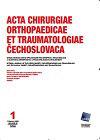用ICD-10分类分析成人手部骨折的流行病学。
IF 0.4
4区 医学
Q4 ORTHOPEDICS
Acta chirurgiae orthopaedicae et traumatologiae Cechoslovaca
Pub Date : 2022-08-15
DOI:10.55095/achot2022/041
引用次数: 1
摘要
研究目的本研究的目的是对成人手部骨折进行流行病学研究。材料和方法对47万居民进行回顾性观察研究。在三年的时间里,所有16岁以上被诊断为腕骨、掌骨和/或指骨骨折或骨折脱位的患者都被纳入研究。这些骨折按照国际疾病分类第10版(ICD-10)进行分类。发病率以及性别和年龄分布也进行了研究。结果纳入1267例手部骨折患者,共1341例。在此期间,他们占所有上肢骨折的29.7%,占所有涉及骨折的创伤性紧急情况的7.6%。最常见的ICD-10组是S62.3,第五掌骨是最常受影响的骨(39.7%)。在指骨水平(S62.5)最常见的位置是第五桡骨近端指骨的近三分之一。全球发病率为每10万人/年99例骨折。未观察到季节变化。只有10.2%的手部骨折接受了手术治疗。一些关于手部骨折的流行病学研究已经发表,但没有一个使用ICD-10分类。虽然我们按年龄和性别分层的样本分布与先前发表的相似,但我们研究的发病率要低得多。鉴于在这些地理区域对这一问题的流行病学研究缺乏,我们可能会将我们的结果外推到西班牙的其他人口,甚至南欧的其他人口。结论ICD-10分类可用于手部骨折的描述和分类。最常受影响的群体是包括长指的掌骨(S62.3),在年轻男性患者中最常见的是第五掌骨远端。大多数骨折采用保守治疗,在手术治疗的情况下,首选的手术技术包括克氏针固定、骨折块间加压螺钉和钢板固定术。关键词:流行病学,发病率,骨折,骨折脱位,腕骨,掌骨,指骨。本文章由计算机程序翻译,如有差异,请以英文原文为准。
Epidemiology of Bone Fractures in the Hand in Adult Population Using the ICD-10 Classification.
PURPOSE OF THE STUDY The purpose of this study was to conduct an epidemiological study of hand fractures in adult population. MATERIAL AND METHODS A retrospective observational study in a population of 470,000 habitants was performed. Over the course of three years, all patients over 16 years of age who were diagnosed with fracture or fracture-dislocation at the level of a carpal bone, metacarpal and/or phalange were included. These fractures were classified according to the International Classification of Diseases 10th edition (ICD-10). Incidence rates, along with gender and age distribution were also studied. RESULTS 1,267 patients with a total of 1,341 hand fractures were included. They represented 29.7% of all upper limb fractures and 7.6% of all traumatological emergencies involving a bone fracture during that period. The most frequent ICD-10 group was S62.3, with the fifth metacarpal as the most often affected bone (39.7%). The most frequent location at the level of the phalanges (S62.5) was the proximal third of the proximal phalanx of the fifth radius. The global incidence rate was 99 fractures per 100,000 persons/year. No seasonal variation was observed. Only 10.2% of hand fractures received surgical treatment. DISCUSSION Several epidemiological studies have been published on fractures in the hand, but none have used the ICD-10 classification. Although the distribution of our stratified sample by age and gender was similar to those previously published, the incidence rate in our study was much lower. We may possibly extrapolate our results to the rest of the Spanish population and even to the rest of the population of southern Europe, given the scarcity of epidemiological studies on this matter in these geographical areas. CONCLUSIONS The ICD-10 classification is useful for the description and classification of hand fractures. The most often affected group is that including metacarpals of the long fingers (S62.3), being the distal level of the fifth metacarpal in young male patients the most frequent one. Most fractures are treated conservatively and in case of surgical treatment, the preferred surgical techniques include K-wire fixation, interfragmentary compression screws and plate osteosynthesis. Key words: epidemiology, incidence, fracture, fracture dislocation, carpal bones, metacarpals, finger phalanges.
求助全文
通过发布文献求助,成功后即可免费获取论文全文。
去求助
来源期刊
CiteScore
0.70
自引率
25.00%
发文量
53
期刊介绍:
Editorial Board accepts for publication articles, reports from congresses, fellowships, book reviews, reports concerning activities of orthopaedic and other relating specialised societies, reports on anniversaries of outstanding personalities in orthopaedics and announcements of congresses and symposia being prepared. Articles include original papers, case reports and current concepts reviews and recently also instructional lectures.

 求助内容:
求助内容: 应助结果提醒方式:
应助结果提醒方式:


